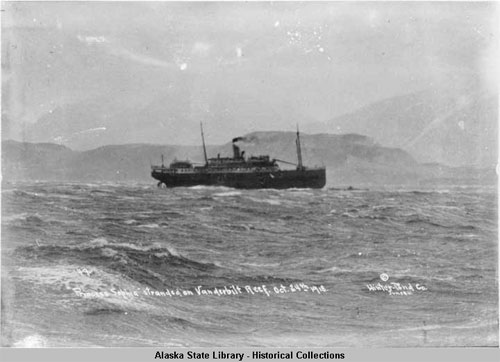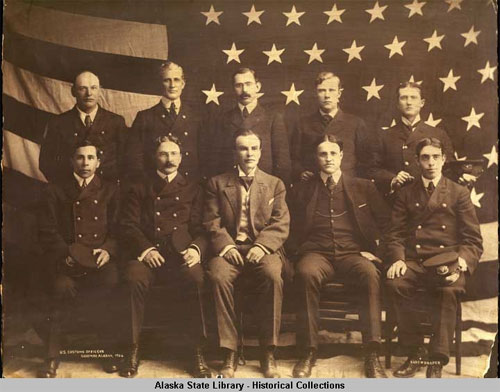 THE GROUNDING OF THE PRINCESS SOPHIA By DAVE KIFFER December 05, 2005
This was a welcome relief for residents of the Capital City as the late summer and fall of 1918 had been one of the wettest periods on record, according to the Alaska Daily Empire. Just a few days before, a large hillside above South Franklin Street had collapsed sending tons of debris onto several businesses and homes. The rain no doubt reminded Pugh - the head of the US Customs Service in Alaska - of his previous posting, more than a decade before, in Ketchikan. Pugh and his wife and young daughter (both named Venetia) had spent three years in Ketchikan and the former St. John's Episcopal Church Vestry member and co-founder of the Ketchikan Masonic Lodge remained popular there, as he was in his other previous postings in Sulzer and Skagway.  Photograph courtesy Alaska State Library - Historical Collections
But Pugh would never get the chance to come back to Ketchikan . The Princess Sophia ran aground on Vanderbilt Reef on the return trip from Skagway. Pugh had survived several previous steamship groundings in his time in Alaska, but this time none of the 350 passengers and crew survived when the Princess Sophia went down on Oct. 25, 1918. It remains the worst marine disaster in the history of the Inside Passage. Of medium height and handsome, Pugh - who was born in Western Washington in 1877 and came to Alaska in 1900, was well-known throughout the state for his cheerfulness, can-do attitude and natty attire. While other customs officials frequently wore the rather bland looking uniforms of the service, Pugh preferred high collars, three piece suits and his golden pocket watch chain. The Daily Empire reported that Pugh believed it was easier to resolve customs disputes if he did not dress like a law enforcement officer. Pugh had been the head of the customs service since 1913. On Oct 22, he was boarding the Princess Sophia to go to Skagway on a trouble-shooting mission, according to Ken Coates' 1990 book "The Sinking of the Princess Sophia." "He was preparing to assist officials at that northern port and to prevent potential problems among the hundreds of people increasingly anxious to secure transportation southward," Coates wrote. C. D. Garfield, the deputy collector of customs had been on the Princess Sophia on its northward journey. "As he passed Garfield on the dock, Pugh told him that his trip to Skagway would likely be a short one, as the imminent arrival of the Princess Sophia promised to ease the congestion. He would travel back to Juneau with the ship." Skagway was indeed clogged with people on the way "Outside" in October of 1918. It was the end of the mining season in the Klondike and even though the gold rush was long over, there were still several hundred people who spent the summers in the Klondike and the winters outside. The October 24th sailing of the Princess Sophia from Skagway was one of the last scheduled trips before the winter storms would make travel from the Klondike difficult if not impossible. As a result, there were more than 400 people either in Skagway or on their way to Skagway, to catch a steamship south, either the Sophia or its sister ship, the Princess Alice, which was also heading up the Inside Passage three days behind the Sophia. In order to hold more passengers, company officials in Vancouver had outfitted the Sophia to carry 350 passengers on its voyage, 100 more than normal, by adding more "buoyancy tanks" and converting unused space on ship to berths. Since the sinking of the Titanic six years earlier, ocean-going ships had been required to provide ample lifeboats and other devices. The buoyancy tanks were designed to remain floating and had ropes in order for the passengers to hang on. The Princess Sophia had joined the Canadian Pacific Inside Passage run in 1912, the year before Pugh was named head of the entire Alaska customs operation. She was a functional if not a particularly pretty ship. "She was not a beautiful princess but a sturdy, somewhat chunky down to earth lady of the seas," wrote Betty O'Keefe in her 1998 book "The Final Voyage of the Princess Sophia." "She was practical, comfortable and soon became popular with those who traveled the West Coast to AlaskaHer cabins provided an uncommon comfort compared to the primitive housing and rigors of isolated living to which they were accustomed." O'Keefe wrote that the ship was referred to by some as the line's "Ugly Duckling" and was slower that the competing ships - the Prince George and the Prince Rupert - of the Grand Trunk Pacific, the forerunner of the Canadian National marine service. While most of the other ships that plied the Inside Passage were low, sleek vessels with only a couple of decks, the Princess Sophia was one of a new breed of passenger ships that had four and five decks and also served as freight haulers. The Scottish built Princess Sophia was 245 feet long, had a beam of 44 feet and 2,320 gross tons. Her high superstructure made her seem a little "chubby" O'Keefe wrote. She had a cruising speed of 14 knots. Like most of the Inside Passage steamships, the Princess Sophia had more than a few accidents. By 1918, she had run aground on three separate occasions, most notably in 1913 on Sentinel Island - just four miles from Vanderbilt Reef - on the run south from Skagway. In 1918, she was under the command of Captain Leonard Locke, who had been helming ships on the northern run for more than 16 years. After the Pugh boarded the Princess Sophia, it pulled away from the Juneau dock. It arrived in Skagway at 1 pm on Oct. 23. The original plan was for the ship to load and head south at 7 pm but the Whitehorse to Skagway train was late the ship was held back as Pugh and the other customs workers strove to "clear" all the passengers and deal with the chaos at the dock.. The Princess Sophia headed south into Lynn Canal at 10:30 pm. The weather, which had been fairly mild for the past couple of days in Lynn Canal, was already beginning to turn and a freshening north wind soon began to push the Princess Sophia southwards. "The weather suddenly worsened and a blinding snowstorm overtook the ship from the north," Coates wrote in his book. "A strong wind, gusting up to 50 mph, whistled over the mountain, blowing heavy snow before it. The water turned rough boiling with heavy rollers and whitecaps. It was a bad storm, but Captain Locke had faced worse and coastal mariners were used to running in white out conditions. He decided not to slow down." William Stokes on the fishing boat "Electo" was also fighting the storm in southern Lynn Canal that night, according to Coates. "Battling the wind and gusts of driving snow, he reached shore, tied a line to a rock and prepared to wait out the storm," Coates wrote. "The frantic tossing of his boat kept him awake, and about a half an hour after midnight he heard in the distance the foghorn of a large ship coming from the north. For over an hour he lay awake following the sound, which approached, passed him and faded to the south as the Princess Sophia made her way at speed down the channel towards Juneau."  Pugh is the second one from the right on the bottom row. Photograph courtesy Alsak State Library - Historical Collections
Exactly what happened next has been lost to history, at some point in the darkness and the swirling storm a navigation error was made and the Princess Sophia began moving to west. At 2:10 am, she ran directly onto Vanderbilt Reef. "Because the reef was so low in the water the bow lifted out of the water and, with a horrible grinding and tearing, slid up and onto the rock," Coates wrote. "Despite the terrific force of the impact, there were few if any injuries because most of the people were in bed." What was going through the minds of the passengers can only be guessed at but at least two letters written by passengers during the time the ship was marooned on the reef did survive the ship's destruction. "I am writeing this my dear girl while the boat is in grave danger," wrote John Maskell in a letter to his fiancee. " We struck a rock last night which threw many from their berths, some were crying, some too weak to move, The life boats were swung out in all readiness, but it would have been madness to launch." Maskell's letter included a hastily scrawled last will and testament. But another passenger, Auris McQueen, was more upbeat in a letter he wrote to his mother. "There was some excitement but no panic," he wrote. "Two women fainted some of the men too, kept on life preservers for an hour or so and it seemed there was no chance for us, but we passed the first danger point we are all mighty lucky we are not buried in the sea water." Captain Locke sent out the first distress calls to company officials in Juneau and Skagway and at dawn the crew assessed the damage. Initially it appeared that the ship had not suffered catastrophic damage and that the double-hulled bottom of the ship was holding. After daylight on Oct. 23 several rescue ships arrived on scene but it was determined to still be too stormy to remove the passengers. It was also decided to wait to see whether the ship would free itself on high as other ships had frequently done in groundings up and down the coast. There was also a general belief amongst the crew of the Sophia and the potential rescuers that the storm was weakening and that it was safer to wait to evacuate the passengers. In light of what eventually happened, the decision to not try to remove the passengers at the earliest possible time was second guessed and faulted in inquiries, stories and books for the next 80 years. The primitive communications of the era also exacerbated the situation. In some cases messages sent from the stranded ship to company headquarters took several hours to arrive and be answered. Communications between the Sophia's captain and the rescue ships standing often had to be delivered by shouting over the wind. According to both the Maskell and McQueen letters, passengers were nervous during the long wait but no panic ensued. There was a general feeling that the ship would either free itself from the reef or the passengers would be transferred onto the other ships. No personal messages were sent from the ship to anyone outside, except for a short message from Jack Pugh to his wife Venetia, who was waiting at the dock in Juneau for his arrival. "High and dry on Vanderbilt Reef; perfectly safe and happy" was all it said. Pugh had traveled the Inside Passage enough to understand that groundings were a fact of life for the steamships in an era of poor communications and even poorer navigational aides. In 1913, he had been one of the survivors when the Pacific Coast Steamship Company's steamer State of California had struck a rock in Gambier Bay south of Juneau and gone down with a loss of more than 30 lives. But when the tide came in, the Sophia didn't float free. Plans were made to take off the passengers the next morning, the morning of Oct. 25th. That morning, the regional newspapers carried the first word of the grounding to the outside world. There were comforting words from company representatives indicating that the bad weather was abating and that the passengers would be rescued soon. But as dawn broke on Oct. 25, it was already clear that the weather was not cooperating. Weather records were not kept for the Berners Bay area of Lynn Canal in those days, but skippers of the boats waiting to rescue the passengers estimated that the wind increased to nearly 100 miles per hour and seas rose to over 30 feet. Even as far away as Sitka, a sharp drop in barometric pressure signaled a major storm. The boats that were standing by the stricken liner agreed to head for shelter behind nearby islands at mid day. At 4:50 pm, the wireless operator of the Sophia, 20-year old David Robinson, sent out a frantic distress message. "Ship Foundering on reef. Come at once." Several of the ships tried to leave their havens but were beaten back by the storm. At 5:20 pm. Robinson sent out another message. "For God's sake hurry, the water is coming into my room." The wireless room was on the top deck of the ship, next to the bridge. The wireless operator on one of the rescue ships made contact with him and suggested saving his batteries by only transmitting if absolutely necessary. "Alright, I will," Robinson answered. "You talk to me so I know you are coming." That was the last message from the Princess Sophia. "For nearly 40 hours the Princess Sophia had sat firmly wedged on Vanderbilt Reef, her stern pointing north into the wind and her bow in the general direction of Juneau," Coates wrote. "Now the wind and waves began to lift the stern off the reef. Under their force the Sophia rose, then swung slowly around in a 180 degree turn as if on a pivot and the Princess Sophia began inexorably to move off the reef into deep water, the rocks ripped gaping holes in her hull tearing out virtually the entire bottom."
As the water rushed in, the ships boilers exploded killing some of the passengers, many others suffocated in the thick bunkler fuel oil that was spilling into the water around. Very few apparently died from drowning, according to the inquest into the sinking. There was evidence that one person, the ship's second officer Frank Gosse, may have made it to shore before possibly dying of exposure. There was a single survivor of the wreck. An English setter owned by one of the passengers was found at Auk Bay, 12 miles from the wreck, starving and covered with oil two days after the sinking. Coates reports that the dog suffered an extreme fear of water for the rest of its life. At seven the next morning, the wind had abated enough for the rescue ships to return to the site. They reported that the Princess Sophia had slipped off the reef and that only the forward mast of the ship was showing above the water. For several weeks, bodies were recovered for miles up and down Lynn Canal. Divers also retrieved many bodies that were trapped in the wreckage of the ship. Jack Pugh's body was found on Oct. 29 at Tree Point on the north end of Douglas Island. Two days later, Oct. 31, he was buried in Evergreen Cemetery. "Jack Pugh was one of the most popular men holding office in the territory and his friends were legion," reported the Daily Empire. "News of the arrival of his body spread like wildfire throughout the town and while it caused sighs of relief, it emphasized the feeling of personal loss to the hundreds of friends of the popular official and citizen. Minds that had been stunned by the awfulness of the catastrophe reverted to introspection and permitted grief that had been held in reserve to find expression." Flags were flown at half mast and banks closed during the funeral. But there was not a large attendance at the gravesite. The first cases of the Spanish Influenza had been diagnosed in Juneau a couple of weeks earlier and the Masons - who conducted Pugh's funeral - asked people to stay away to prevent spread of the burgeoning epidemic. The sinking itself was only big news for a matter of days, until the World War I armistice knocked it off the front pages. Among the mourners were Pugh's wife and teenaged daughter. Venetia Pugh later remarried and became the deputy clerk of the US Court in Juneau. She also co-owned a tea shop. She died in Anchorage as Venetia Pugh Reid in 1967. In 1930, she created a crazy quilt commemorating the events of her life. It was made out of her old dresses and the ties that Jack Pugh had worn. That quilt is now owned by the Alaska State Museum.
Contact Dave at dave@sitnews.us Dave Kiffer ©2005
|
||
